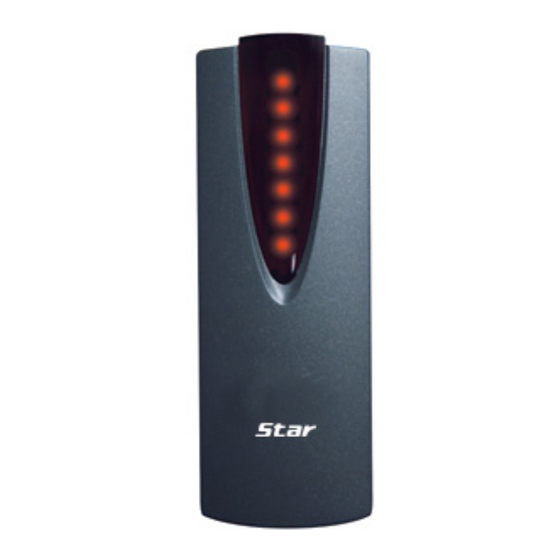Table of Contents
Advertisement
Quick Links
Advertisement
Table of Contents

Summary of Contents for IDTECK Star RFL200
- Page 1 User’s Manual Proximity Access Controller...
-
Page 2: Table Of Contents
Table of Contents 1. Important Safety Instructions..............3 3. Features......................4 4. Identifying Supplied Parts ................4 5. Specification ....................5 6. Installation.....................6 7. Color Coded & Wiring Table ................7 8. Wire Connection to Controller..............7 9. Operation.......................8 10. FCC Registration Information..............10 11. Warranty and Service ................11... -
Page 3: Important Safety Instructions
Proximity Single Door Access Controller which can be mounted to a metal door frame (mullion) or to any flat wall surface. The Star RFL200 / iPASS RFL200 is epoxy potted that ensure you a successful operation even in harsh environments. Using 512 key tag, not only controlling door but also convenient registration or deletion. -
Page 4: Features
3. Features - 125KHz Standalone Proximity Access Controller - Star RFL200: PSK Modulation iPASS IP-RFL200: ASK[EM] Format - 512 Users including One Master Card - Standalone (No need application software) - Direct Control of Door Lock - Power Fail Safe or Power Fail Secure Locks selectable... -
Page 5: Specification
5. Specification Model RFL200 IP-RFL200 Dual 8bit Microprocessor Program Memory 64KByte Flash ROM Memory Data Memory 4KByte EEPROM User 512 Users (Including 1 Master Card) IDK50 / IMC125: IPK50: Up to 2 inch (5cm) Up to 2 inch (5cm) Read... -
Page 6: Installation
6. Installation 6-1. Drill one 0.5”(12.7mm) hole at the central of the RFL200 / IP-RFL200 on mullion or wall mount. Route the cable of reader module through the central hole. 6-2. Drill one 0.39"(10mm) in right horizontal and 1.74"(44.4mm) in upper vertical through the central hole. -
Page 7: Color Coded & Wiring Table
7. Color Coded & Wiring Table SIGNAL COLOR Main Power (+12V) Power Ground (GND) Black Aux In 1 Yellow Door Contact In Blue Exit Button In Green Alarm Out Purple Door Lock Out White Not Connect Gray Not Connect Orange Not Connect Brown * Please cut out tail connector before installation. -
Page 8: Operation
(3) RFL200 / IP-RFL200’s buzzer sounds one time 9-2. Whether registered key tag is read on RFL200 / IP-RFL200 or an exit button is pressed (1) All LEDs turn from red to green. From the top to the under, they are off and on in order. - Page 9 (4) As power off, RFL200 / IP-RFL200 operates normally. At this time, a card which had been first read on RFL200 / IP-RFL200 is registered as a master card. If you make already registered user card read, it will be deleted and then registered as master card.
-
Page 10: Fcc Registration Information
10. FCC Registration Information FCC REQUIREMENTS PART 15 Caution: Any changes or modifications in construction of this device which are not expressly approved by the responsible for compliance could void the user's authority to operate the equipment. NOTE: This device complies with Part 15 of the FCC Rules. Operation is subject to the following two conditions;... -
Page 11: Warranty And Service
11. Warranty and Service The following warranty and service information applies only to the United States of America and Republic of Korea. For the information in other countries, please contact your local distributor. To obtain in or out of warranty service, please prepay shipment and return the unit to the appropriate facility listed below. - Page 12 The specification contained in this manual are subject to change without notice at any time 5F, Ace Techno Tower B/D, 684-1, Deungchon-Dong, Gangseo-Gu, Seoul, 157-030, Korea Tel : +82-2-2659-0055 Fax : +82-2-2659-0086 E-mail : webmaster@idteck.com MAML20HE3X May.2006 Copyright © 2006 IDTECK Co., Ltd.










Need help?
Do you have a question about the Star RFL200 and is the answer not in the manual?
Questions and answers